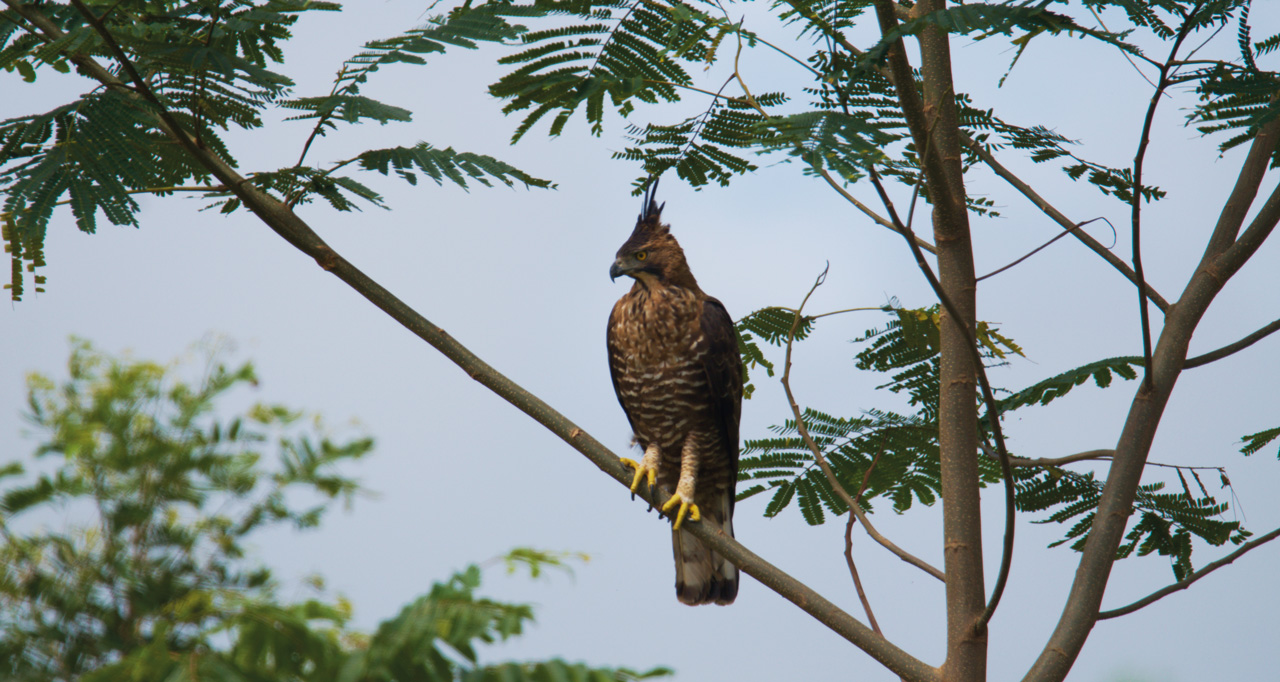
Javanese Eagle in Tujuh Bukit Forest
The Javan eagle makes the Tujuh Bukit forest its habitat. It takes seriousness together so that its existence is maintained.
All eyes are looking in all directions with vigilance, observing every movement of wildlife in the canopy of the Tumpang Pitu forest. Even though the sun was starting to get hot, everyone was still looking at the sky, ready to take pictures with the long-range camera every time the eagles and hornbills flew past. Moments later, there was a muffled shriek of joy. Bagus Susesono managed to capture an eagle sitting perched on a dry tree around PT Bumi Suksesindo’s B-East Pit.
“This is a Javan eagle,” said Bagus, staff of the East Java Natural Resources Conservation Center (BBKSDA), with a happy face.
PT BSI’s Enviro Team, which that day, to be precise in August 2018, jointly monitored fauna with the East Java BBKSDA, immediately became infected with joy. The encounter with the Javanese eagle that day was the first at Tumpang Pitu. However, a one-time encounter is not enough to conclude that the Javan eagle makes the Tujuh Bukit forest its habitat. There must be continuous monitoring to ensure the presence and count of the population.
It’s true, that throughout 2019, the Enviro Team did not once encounter a Javan eagle. “The Javan eagle population is very low in nature,” said Setiawan, Enviro Bumi Suksesindo staff. Being able to see this dashing and handsome bird fly is a blessing, it can even be a miracle. However, in 2020, luck changed, and encounters with Javanese eagles increased dramatically. “It’s quite encouraging, there have been four encounters,” said Wawan, Setiawan’s nickname.
One of the encounters with the Javanese eagle was captured on a cellphone camera by a mining technician. He managed to photograph the eagle perched on the embankment around Pit C at six in the morning.
“The Javan eagle was already in the area in the morning indicating that it is not far from its nest,” said Wawan.
The spread of the Javan eagle in East Java is generally in conservation areas such as Mount Bromo Tengger Semeru National Park, Meru Betiri National Park, Ijen Crater Nature Park, and Alas Purwo National Park, and Baluran National Park. There is very little information about encounters with Javanese eagles outside other conservation areas. However, if you look at the Tumpang Pitu landscape in the form of a lowland forest ecosystem that is still supported by habitat connectivity with natural forests around it, the Javan eagle may inhabit the Tumpang Pitu forest.
The Javan eagle with the scientific name Nisaetus bartelsi is a species of bird of prey in the family Accipitridae. This bird lives in natural lowland forests to hilly forests to an altitude of 2000 meters above sea level and is very rarely found in plantation forests. This eagle is very easily recognized by its crested head, and hairy legs characteristic of the eagle from the Nisaetus clan, the dominant color is red-brown, the chest is white with streaks across in adult birds, and plain brown in young birds. Another description of the Javanese eagle’s figure is that its eyes and eyesight are very sharp, its beak is sturdy, and when it is silent its posture is dashing and dignified.
This description of the Javan eagle is what Ismed G. Siregar, Manager of HSE (Health Safety Environment) saw in the trees around the MIA (Mine Infrastructure Area) area. Ismed, who happens to always carry a digital zoom camera to share his passion for wildlife photography, managed to capture this beautiful bird after the meeting agenda at the MIA office.

The Tumpang Pitu Forest provides a variety of prey for Javan eagles such as small birds, rodent mammals (squirrels, squirrels), fruit bats, mongoose, monkey chicks, and reptiles. Generally, these birds of prey hunt by flying near the tree canopy or perching on trees and waiting for prey to pass. From the many encounters, the distribution of the Javan eagle is thought to be in the southern part of the Tumpang Pitu area, such as around the Mining and Buffer Zone areas. Meanwhile, the reclamation area at CWD (Central Waste Dump) Mining which is already overgrown with trees has become one of the hunting areas.
“The nest is thought to have been built on a sticking tree because several times it has been observed flying into the forest part of the Buffer Zone where there are still many trees with large diameters and towering heights,” said Wawan.
The Javan eagle is not the only predatory bird that inhabits the Tumpang Pitu forest habitat. Enviro’s team noted that there are about seven species of resident eagles, including the bido snake eagle (Spilornis cheela), white-bellied albatross (Haliaaetus leucogaster), brontok eagle (Nisaetus cirrhatus), rust-bellied eagle (Lophotriorchis kienerii), crested hawk-eagle (Lophotriorchis kienerii), beautiful crested eagle (Accipiter trivirgatus), cow kestrel (Falco moluccensis), and dragonfly kestrel (Microhierax fringiilarius).
In the last three years, the Tumpang Pitu forest has also been visited by local migratory predatory bird species, such as the rat eagle (Elanus caeruleus) and tiger alps (Falco severus). The large number of birds of prey living in the Tumpang Pitu forest habitat, which is not too wide, makes the birds have to fight over each other for food, resting places, and nests.
In an ecosystem, the Javan eagle has a very important role, namely as a top predator, controlling the ecosystem. The Javan eagle is very sensitive to environmental changes so if the environmental quality is disturbed, the Javan eagle is expected to soon become extinct and the balance of nature is disturbed. The Javan eagle also has a dual role, namely as a keystone species or species that can affect ecosystem change; and umbrella species or species with a wide distribution area. Based on this role, other species in the area can be protected when this species is protected.
In general, the situation of the Javan eagle is now increasingly concerning. The population trend of the Javan eagle, which is often considered synonymous with the Garuda Bird, the symbol of the Republic of Indonesia, is decreasing. This endemic bird of Java is included in the endangered category with an endangered status according to the International Union for Conservation of Nature (IUCN) red list. This species is also designated as a conservation priority animal listed in the Minister of Forestry Regulation No. 57 of 2008 and has a protected status based on the Minister of Environment and Forestry No. 106 of 2018 concerning Protected Types of Plants and Animals.
The decline in the Javan eagle population in the wild is caused by habitat destruction, fragmentation of forest areas, hunting, and trade. This is also exacerbated by the length of the breeding period, which only produces an egg in two to three years. According to BirdLife International data, the population of Javan eagles in the wild is estimated to only be around 300–500 adult individuals. In line with these data, the population of Javan eagles in the Tumpang Pitu forest is estimated to be only two.
Given its function in nature as a top predator in the food chain and an indicator of the sustainability of its habitat, the Javan eagle needs serious attention to ensure its sustainability. Therefore, PT BSI makes efforts to protect and preserve the Javan eagle, namely utilizing habitat conservation and species conservation.
Habitat conservation is done by minimizing forest clearing. Forests were cleared only for mining operations and immediately reclaimed clearings that were not needed. Species conservation is expected to increase the population of Javan eagles. Ways that can be done are monitoring periodically to count the population and identify home range (home range), territory (area to be defended), and nesting places; ensure that employees and partners protect the Javan eagle and prevent local hunting; and conducting captive (ex-situ conservation) Javan eagles, in collaboration with the Animal Rescue Center (PPS) in East Java.



